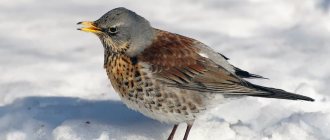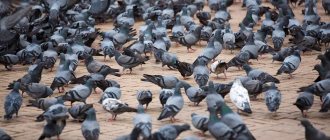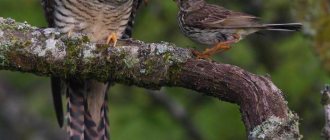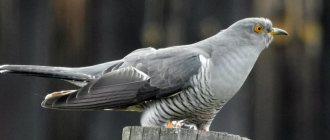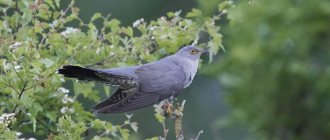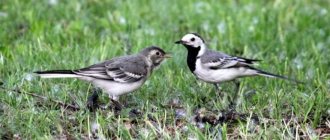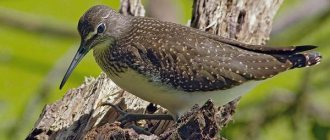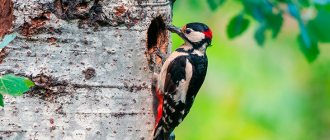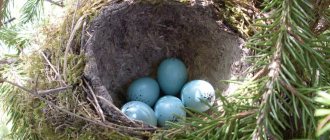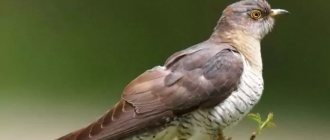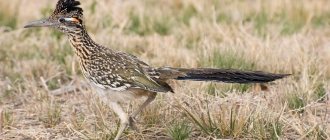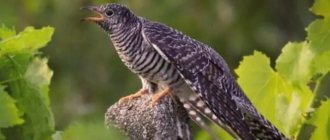Perhaps even a child knows the voice of the cuckoo. Rhythmic peek-a-boo can often be heard in the forest, garden, and country house. But rarely can anyone recognize this secretive bird by its appearance.
What the cuckoo eats, what it looks like and what kind of life it leads - these questions are of interest to many. This will be discussed in the article.
Origin of the species and description
Photo: Cuckoo
In modern classification, cuckoos as birds constitute a separate family of cuckoos, which includes 140 individual species. Externally, these birds are quite different from each other, both in color and size. The sizes vary over a fairly wide range. Some species are only 17–20 cm in length, others reach 70 cm.
Video: Cuckoo
The most famous representative of the family is the common cuckoo, which originally gave its name to the entire family. The name itself comes from the onomatopoeic cry of a male bird.
Interesting fact: The closest relatives of cuckoos are birds such as banana-eaters, turacos and hoatzins, which previously, together with cuckoos, were part of the order of new palate birds. In the current classification, only cuckoos remain in this order.
All representatives of cuckoos have a common appearance. They have a rather elongated, streamlined body. The wings are long in proportion to the rest of the body. The tail is also long and has a stepped shape. The legs are very similar to a passerine's, but are of medium length. In addition, the toes on the paws are directed two back and two forward. This structure of the cuckoo's paw brings it closer to representatives of parrots. The beak of a cuckoo, regardless of the size of a particular species, always has the shape of a sharp hook at the end.
Appearance and features
Photo: Cuckoo bird
In appearance, the common cuckoo resembles a sparrowhawk. Particularly similar are the plumage details, head shape and flight style. This similarity helps cuckoos survive. The size of a cuckoo is comparable to the size of a pigeon. The length of the bird is approximately 33 cm, weight is about 100–180 g. The wingspan is in the range of 56–65 cm. The tail is wedge-shaped, quite long, therefore, in combination with small wings, it helps the bird to maneuver well in the thickets. The legs are short, but very strong, and are usually not visible when sitting.
Interesting fact: The paws have a so-called zygodactyl structure. Two toes of the cuckoo are directed forward, and two are directed back, like those of woodpeckers and parrots. This allows it to hold well on branches, but makes it difficult to move on a flat horizontal surface.
The plumage of cuckoos is quite rigid. They have long “pants” on their legs. Male cuckoos are usually completely dark gray in color, while females have a brownish rusty tint on the back with small buffy patches on the neck and white with transverse stripes on the belly and chest.
Most of the time, the common cuckoo is silent and leads a secretive lifestyle. But in the spring, as well as in the first half of summer, male birds become very noisy and noticeable, trying to attract attention to themselves. At this time, in the forest and parks you can hear a characteristic loud “ku-ku, ku-ku” with multiple repetitions and intensification on the first syllable. In calm weather, the bird's voice can be clearly heard at a distance of up to two kilometers.
general characteristics
Cuckoos are small birds, measuring about 32-38 cm in length and weighing about 140 grams. They have a long tail, reaching half the size of their body. The wingspan of the cuckoo is at least 50 cm.
The body of cuckoos is long and thin, there are short, not very developed legs. They are colored yellow, the beak is dark and slightly curved. The structure of the paws is formed in such a way that two claws are directed forward, and the other two look back.
Birds have sexual differences that manifest themselves in appearance. Adult males have a darker color on the tail and back, while the plumage on the throat and chest is light gray. There are dark stripes on the body. Females have more red and brown shades in their plumage. Dark stripes are located across the body, and the feathers are edged with white. In the chest area the color is light. In addition, males are larger than females.
Differences between males and females of different species
Cuckoos molt twice a year. The first time this happens in the summer, the second time in the winter.
Where does the cuckoo live?
Photo: Cuckoo in nature
The range of all species of cuckoos extends to all continents, with the exception of Antarctica. Covers almost all climatic zones from forest-tundra to the tropics. The largest number of species is found in Eurasia and North America, mainly in tropical areas. Common cuckoos are common in northern latitudes. They inhabit most of Europe and Asia, are distributed from the Atlantic to the Pacific Ocean and are found even in the Kuril Islands, Commander Islands, Japan and the Korean Peninsula. The northern border of the range of common cuckoos coincides with the border of the distribution of woody vegetation.
Common cuckoos are typical migratory birds. They do not stay in nesting areas for more than three to four months throughout the year. The distance to winter places from nesting sites of cuckoos can reach 5–6 thousand kilometers.
For wintering they usually fly to southern regions, such as:
- Africa;
- India;
- Southern China.
Common cuckoos prefer to settle in deciduous forests, less often in bush thickets on rough terrain, in forest belts or on island forests in the forest-steppe. Cuckoos avoid taiga and coniferous forests. In Central Asia, in places where there is very little woody vegetation, they can settle in open landscapes if there are isolated trees or shrubs nearby.
Cuckoo bird. Cuckoo lifestyle and habitat
The familiar cooing of a bird, associated with many folk signs, was heard by everyone in the forest, in the park or in the garden. The name of the birds is an onomatopoeia of their characteristic song with multiple repetitions.
In everyday life, cuckoos are the name given to bad mothers who left their children to be raised by strangers. The name, which has become a household name, is associated with the peculiarities of raising offspring. But not all types of cuckoos are the same; their behavior does not deserve an unambiguous assessment.
What does a cuckoo eat?
Photo: Russian cuckoo
Cuckoos are considered omnivores. Most of the diet of these birds consists of insects, but it may also include plant foods, such as berries or young shoots.
Favorite food of cuckoos:
- grasshoppers;
- mosquitoes;
- cabbage worms;
- ant larvae;
- beetles;
- butterflies (and pupae);
- caterpillars;
- slugs
Cuckoos readily eat many poisonous and hairy caterpillars that other birds are afraid to eat. Sometimes they eat small lizards and even feast on bird eggs. Prey is usually picked up from the ground or from branches; insects are less often caught on the fly.
Despite the rather small size of the birds, they are very voracious. This is directly related to the accumulation of subcutaneous fat, which they need for long-distance flights during winter migration. The appetite of cuckoos decreases only during the mating season, when all their energy and attention are devoted to finding a mate. Gluttony is also characteristic of cuckoo chicks, which gain weight and size much faster than the chicks of all other birds.
Interesting fact: In one hour, one adult bird can eat about 100 caterpillars. And the average daily norm is at least 1,500 caterpillars.
It is believed that the destruction of large numbers of insects by cuckoos is a very important factor in protecting the forest ecosystem and ensuring its balance. Therefore, cuckoos are not harmful birds, but rather useful ones, despite the peculiarity of raising their chicks.
Is the cuckoo beneficial or harmful?
Nature is created in such a way that there is nothing superfluous in it. All living things have the right to live side by side with other groups of animals, birds or plants. The cuckoo protects plants from the invasion of caterpillars by eating them. And since these birds do not suffer from appetite, the benefits to the forest are excellent. A huge number of harmful insects are eaten by this bird.
The cuckoo benefits the forest by eating pests, which not all birds eat. If the bird did not like to feast on caterpillars, then there would not be so much greenery in our forests.
Features of character and lifestyle
Photo: Cuckoo
The average lifespan of a common cuckoo is from 9 to 11 years. Cuckoos are secretive and cautious birds and try to lead a silent lifestyle. The characteristic cooing is heard only during the mating season from mid-spring to mid-summer. They leave practically no traces of vital activity, making it difficult to observe themselves.
The bird's lifestyle is predominantly diurnal; most of the time the bird is busy eating food. Due to the structure of its paws, the cuckoo is not adapted to moving on the ground, so even if it descends for prey, it immediately flies up and eats the caught insect or lizard on the branch of the nearest tree. Because of this feature, the cuckoo also leaves almost no paw marks on the ground.
Birds do not make or build their own nests. Common cuckoos are one of the most advanced nest parasites. They never raise chicks, and throw their eggs into other people's nests. As a result, the feeders and educators of the cuckoo chicks are completely foreign birds.
Interesting fact: Evolution has led to the fact that the cuckoo can lay mimic eggs that completely repeat the color of the eggs of those birds in whose nests they will be placed. At one of the exhibitions, about a hundred cuckoo eggs of various colors were displayed, from white, inconspicuous spotted ones, to bright blue.
Laying an egg in someone else's nest takes only a few seconds. Before this, the male cuckoo may circle over the nest, pretending to be a predator. Taking advantage of the fact that the owners are leaving the nest at this time, the female flies up to it and lays her egg. Sometimes cuckoos also lay eggs in hollows, and if the bird cannot fly there, it can lay an egg nearby and then deliver it into the hollow using its beak.
Lifestyle and habitat
Birds have chosen many habitats, covering almost the entire globe, except Antarctica and Antarctica. Cuckoos spread massively across the American continent and Eurasia.
Birds are attracted to the warm climate and areas with extensive deciduous forests. They do not like dense taiga with impenetrable thickets of dark coniferous plants. In many sparse forests, most species of cuckoos have colonized the upper layers of trees, only a few have settled in the forest-steppe. Evolution has gradually adapted birds to open spaces.
determine whether a cuckoo is a migratory bird or not by looking at its nesting site. Those species that hatch their chicks in the temperate zone fly to Africa, China, and India for the winter. Birds of North America migrate to Argentina.
During seasonal migrations, cuckoos travel more than 3,000 km without rest; the total distance from nesting sites reaches 6,000 km. Tracking migrations is difficult due to the secretive nature of the birds. Cuckoos do not flock together.
They fly slowly, conserving their strength. Wintering in the southern regions lasts approximately 3 months. In the tropics, the cuckoo is a wintering , sedentary bird.
Despite the prevalence of cuckoos, they are difficult to observe. They lead a solitary life, only breeding time attracts them to each other. Birds know the forest and the birds inhabiting it very well. The survey of the territory is measured in hectares.
As a nesting parasite, the mysterious cuckoo bird selects foster parents for its offspring. Hundreds of bird species became unwilling guardians. The cuckoo itself does not bother building a nest or caring for the chicks. It is no coincidence that the name of the bird has become a household name for grief-stricken mothers who abandoned their own children.
Among the numerous species there are many tropical cuckoos that are quite capable of feeding and raising offspring. Therefore, all birds should not be considered parasites. The social benefit of birds is the destruction of forests and gardens from harmful insects and caterpillars.
Social structure and reproduction
Photo: Little Cuckoo
Common cuckoos are completely solitary and polygamous. They do not gather in flocks, and pairs form only for one season. But at the same time, the mating rituals of these birds are quite filled with romance. Usually the male waves his tail like a fan and invites the female. Her lowered head and wings are signs of recognition and calling. The male may also bring a gift of a twig or stem as a sign of attention. Reproduction occurs from mid-spring to mid-summer.
Cuckoos do not have a nesting territory in the generally accepted sense. In the same area you can find one female and several males, and vice versa. A nesting area can be considered an area where a female cuckoo looks for other people's suitable nests in order to lay her eggs in them, one in each. But sometimes two females are found in the same area. In this case, they parasitize birds of different species.
Interesting fact: The incubation period of common cuckoo eggs is 11, less often 12 days. Therefore, the cuckoo baby is born earlier than its half-brothers and gains a significant advantage over them in the fight for food brought by its adoptive parents.
For the first four days, the behavior of the chick is aimed at displacing the remaining eggs and hatched chicks from the nest. The cuckoo sits under another chick, and then backs away to the edge of the nest, where it sharply straightens up so that the victim flies down. He does this instinctively, and after four days the instinct disappears.
The independent existence of the cuckoo begins 40 days after hatching, when the bird's plumage is fully formed. Until this time, the chick eats its adoptive parents. Feeding occurs constantly, even when the cuckoo grows larger than the birds feeding it. The cuckoo chick can leave the nest even after 20 days, but due to the fact that it makes characteristic cries asking for food, its foster parents continue to feed it even after that.
Natural enemies of cuckoos
Photo: Cuckoo
Adults have very few enemies, which is due to the agility of flight of the common cuckoo and the similarity of its appearance to birds of prey.
Very rarely and under certain circumstances, a cuckoo can be attacked by:
- orioles;
- gray flycatchers;
- warblers;
- shrikes;
- some other birds.
Attacks occur mainly on chicks that have just left the nests of their adoptive parents, and for this reason have not gained sufficient experience and dexterity in flight.
Predatory mammals such as foxes, martens, weasels and cats can also pose a particular danger to birds. But cuckoos very rarely fall into their clutches, for the simple reason that they try not to approach the surface of the earth at all, and if they do descend, it is only to attack their prey, the choice of which is carried out carefully and carefully.
Nest predators such as crows and jays also pose a danger to cuckoo chicks and eggs. Despite the fact that cuckoos do not build their own nests at all, but lay eggs in others’, other people’s nests are also quite often destroyed, so the chicks in them can be killed, and the eggs can also be eaten by a predator that has climbed into the nest.
What biovars of Vibrio cholerae do you know?
Of these, cholera disease is caused only by Vibrio cholerae of serogroup O1. There are two biovars (biotypes) of this serogroup: classic (Vibrio cholerae biovar cholerae) and El Tor (Vibrio cholerae biovar eltor).
Interesting materials:
What do likes on a stream give? What do megapixels give in a camera? What do MHz give in a video card? What do you get for registering at McDonald's? What does an oak tree do in the fall? What does the swallow elixir do? What does caps do? What does the heart of the sea do? What is made from foil? What to do with cars that have been sitting in the yard for a long time?
Population and species status
Photo: Cuckoo bird
The common cuckoo is a species of least concern. Its range is quite extensive. In Europe today there are about two million couples. For this reason, the birds are not classified as protected, and no additional measures are being taken to increase their population.
Interesting fact: During a season, a cuckoo can lay about 20 eggs. Usually every fifth chick survives to adulthood.
Unpretentiousness, good adaptability, a large amount of varied food and the absence of significant enemies help cuckoos survive. It also helps that cuckoos can eat poisonous caterpillars, which other birds neglect, so even in difficult times they are not afraid of interspecific competition.
However, in some regions, the number of common cuckoos is also declining, which is associated with the development of urban areas and a decrease in woody vegetation. That is, the reason for the decline is the disappearance of the bird’s natural habitat. In 2001, the species was listed in the Moscow Red Book, in the second category, as a species with a declining population. Today, there are no significant changes in the condition of this species, either upward or downward, compared to the period 1990–2000.
